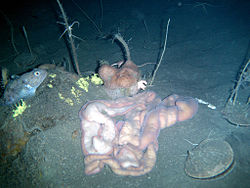| Heteronemertea | |
|---|---|
 | |
| An example of Heteronemertea, the Parborlasia corrugatus | |
| Scientific classification | |
| Kingdom: | Animalia |
| Phylum: | Nemertea |
| Class: | Pilidiophora |
| Order: | Heteronemertea Bürger, 1892 |
| Families | |
Heteronemertea is a monophyletic order of about 500 species of nemertean worms. It contains genera such as Lineus and Cerebratulus , and includes the largest and most muscular nemerteans.
Almost all heteronemerteans have three primary body-wall muscle strata: an outer longitudinal, a middle circular, and an inner longitudinal. The lateral nerve cords are outside the circular muscle, as in palaeonemerteans, but separated from the epidermis by the usually well-developed outer longitudinal muscle. [1]
